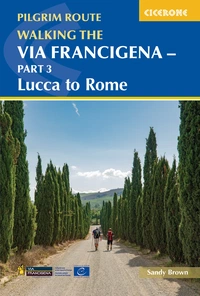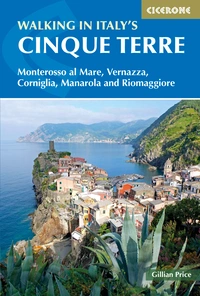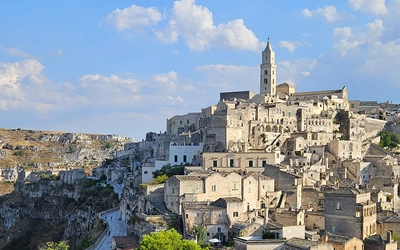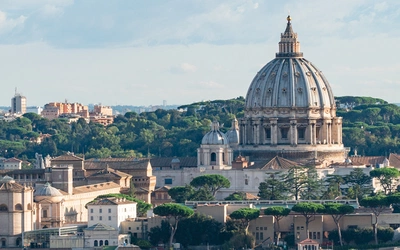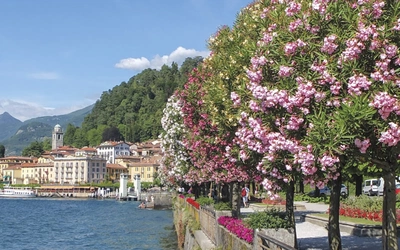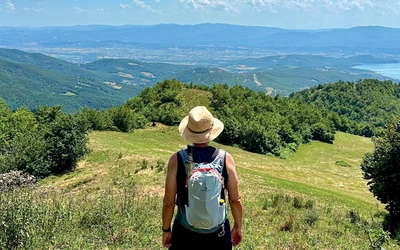Everything you need to know about walking the Via Francigena in the South
Have you walked the Via Francigena to Rome? Or are you planning your first steps on this historic pilgrimage? The fourth and final section of Europe’s longest waymarked trail leads from the Eternal City to Santa Maria di Leuca, at the very tip of Italy’s heel. In this Q&A, we cover everything you need to know about Part 4 of the route: the landscapes, the logistics, and why it’s perfect for travellers seeking an authentic, off-the-radar Italian experience.
Walking the Via Francigena Pilgrim Route - Part 4
Rome to Monte Sant’Angelo, Bari, Brindisi and Santa Maria di Leuca
£18.95
Guidebook to the final 940km of the Via Francigena pilgrimage route, from Rome to the heel of Italy. The route passes through Lazio and into Campania before traversing Puglia, where it concludes at Santa Maria di Leuca. Described in 52 stages, including alternative routes, with information on facilities and pilgrim hostels.
More information
What is the Via Francigena — and what lies beyond Rome?
The Via Francigena is a historic pilgrimage route from Canterbury to Rome, first recorded in the 10th century by Sigeric the Serious, Archbishop of Canterbury. It runs through England, France, Switzerland and Italy, ending at the Vatican — but the road doesn’t stop there. In 2019, the European Association of the Via Francigena (EAVF) officially recognised and waymarked the Via Francigena in the South, linking it to the Canterbury–Rome route and extending the full pilgrimage through Lazio, Campania and Puglia to Santa Maria di Leuca on the southernmost tip of mainland Italy.
The VFS traces the footsteps of ancient pilgrims, including the Bordeaux Pilgrim of AD 333–334, the earliest known traveller to document his journey from Western Europe to Jerusalem and back via Otranto. Much of his route followed Roman roads like the Via Appia and Via Traiana, built in 312 BC and AD 114 respectively. Though sections are now buried beneath modern roads or reduced to quiet tracks, the VFS sticks close to the original paths, passing Roman milestones, mausoleums, aqueducts, and sacred shrines.
How is the Via Francigena divided? How does it connect to the rest of the Via Francigena?
Most pilgrims walk the full Via Francigena in sections. These are:
- Part 1 – Canterbury (England) to Lausanne (Switzerland) – 1090km
- Part 2 – Lausanne (Switzerland) to Lucca (Italy) – 725km
- Part 3 – Lucca (Italy) to Rome (Italy) – 410km
- Part 4 – Rome (Italy) to Santa Maria di Leuca (Italy) – 940km (a 252km variant to Monte Sant’Angelo, one of Southern Italy’s most important religious sites, offers pilgrims a chance to walk in the footsteps of St Francis of Assisi).
How does the VFS compare to the other parts?
The Via Francigena in the South offers a quieter, more rural walking experience compared to the better-known route north of Rome. It passes through three regions — Lazio, Campania and Puglia — and nine provinces, covering a wide range of landscapes and cultures. In Lazio, walkers pass volcanic lakes, ancient forests and hilltop towns with views over the Tyrrhenian Sea. Campania is more mountainous and remote, with forested hills, quiet trails, and panoramic scenery. The route here is less visited by tourists, and the infrastructure can be sparse. In Puglia, the terrain becomes more open and sunbaked, with fishing villages on the Adriatic and Ionian coasts, olive groves inland, and a long coastline with sea caves and quiet beaches.
What makes this route different is its authenticity and variety. You’ll pass through areas where tourism is minimal and local life is very much present. Dialects and food traditions change between regions, and the pace of travel encourages a closer connection to the surroundings. The southern route remains less developed and less busy than the path to Rome, appealing to experienced walkers and returning pilgrims looking for a deeper, off-the-beaten-track experience.
When’s the best time to walk the Via Francigena in the South?
Winter is cheaper but colder, with temperatures as low as -4°C in the north and possible snow. Summer (June–August) can be very hot, especially in Puglia, with temperatures reaching up to 40°C, and accommodation prices soar. The best months for walking are May, June, September, and October, when temperatures are mild (13°C–24°C). Puglia is also pleasant in March and April.
Expect rain from October–May, particularly in the north. The south remains drier year-round.
How should I plan my route and timings on the VFS?
The guidebook divides the route into 52 walking stages, with optional variants and notes for those breaking it into smaller trips. Most people take 6 to 8 weeks to complete the full route, depending on pace, rest days and how often they detour to explore. Many split it across multiple years or return to complete different stages.
- There are good public transport links from places like Rome, Benevento, Lucera, San Severo, Bari, Brindisi and Lecce.
- A popular option is to start in Lecce and walk the final 100km to Santa Maria di Leuca, which qualifies for the Testimonium. Others begin in Bari, walking the 13-day route along the Puglian coastline.
- Walking the full route from Rome to Santa Maria di Leuca takes roughly 45 days via the direct inland path. From Troia, you can either continue inland to Bari (10 days), or take a scenic detour via Monte Sant’Angelo and the coast. This variant passes through Gargano National Park, San Giovanni Rotondo, and coastal towns like Trani and Barletta. It adds an extra day and around 60km, totalling 46 days overall.
What are the accommodation options?
Accommodation along the VFS is varied, though most options are hotels and B&Bs, as pilgrim-specific lodgings are still developing (as of 2024). Always book ahead, even for places listed in the guidebook, as availability can be limited. Sites like booking.com are useful for checking prices and vacancies. Most lodgings expect advance reservations, often with a bank transfer.
Here’s what to expect:
- Pilgrim-specific lodgings (e.g. church or monastery stays) are limited but usually open year-round. Many cannot be contacted in advance — just turn up and knock.
- Religious accommodation is often donation-based, with simple facilities (no bedding, heating, or meals).
- Hostels exist in larger cities like Rome and Bari, offering low-cost dorm beds.
- Locals’ homes in a few towns offer donation-based hospitality in spare rooms.
- Hotels, B&Bs, and agriturismo are the most common and usually include breakfast. Prices vary seasonally.
- Apartments can be booked in advance online and are ideal for self-catering.
- Campsites (seasonal, April–September) are listed in the guidebook. Wild camping is not permitted in Italy, and fires are prohibited.
A full list of accommodation — including downloadable updates — is available in the downloads section of the guidebook page. Directories are also maintained by the EAVF and Dodici Group.
What’s the food like along the Via Francigena in the South?
Expect fresh, local, and flavour-packed Italian cooking wherever you go. From hearty pasta dishes and regional meats to exquisite seafood and seasonal vegetables, meals are rarely disappointing. You’ll find everything from pastries and panini to full four-course dinners and, of course, plenty of gelato. In Puglia, highlights include orecchiette pasta, burrata, and some of the best olive oil in Italy.
Do I need to speak Italian to walk the VFS?
It certainly helps. While some accommodation providers speak English, many do not. A few key phrases will go a long way, and Italian hospitality makes up for any gaps in language.
What is the credenziale and why is it important?
The credenziale is a pilgrim passport that identifies you as a pilgrim and lets you collect stamps (timbri) from lodgings, eateries, churches, and cathedrals along the route. It's essential for accessing donation-based accommodation, receiving occasional discounts (e.g. meals, drinks, 10% off Trenitalia/Trenord and Flixbus in low season), and claiming your Testimonium (certificate of completion).
You can purchase one for about €8 (cash) from locations listed on the Via Francigena website.
What about the Testimonium?
The Testimonium is a scroll-style certificate of completion awarded to those who walk at least 100km or cycle 200km on the Via Francigena in the South. You must stamp your credenziale twice daily over the final qualifying distance. You can collect your Testimonium from these locations:
- Rome/Vatican City: Walk from Priverno. Go directly to the cloakroom at St Peter’s Basilica with your credenziale to skip the queue.
- Monte Sant’Angelo: Walk at least 100km from Troia. Ask at the Basilica Santuario’s main entrance.
- Brindisi: Walk from Bari (north) or Vignacastrisi (south). Request your certificate in advance by emailing br.antichestrade@gmail.com or WhatsApp +39 388 113 0368. Collect it from the Accademia degli Erranti.
- Santa Maria di Leuca: Walk from Lecce. Collect at the sacristy in the basilica, or pre-request on the Cammini de Leuca website.
Anything else I should know before walking the Via Francigena in the South?
- Yes — this route can be more expensive than walking a Camino in Spain, especially for solo travellers, as accommodation often charges per room, not per person. Daily budgets range from €15 to €150+, depending on where you stay and how you eat. Pizzas and shared salads can keep costs down, and Italian portions are generous.
- Unlike in northern routes, there’s no luggage transfer service (except in Lazio), so pack light and prepare your feet and gear well in advance — blister prevention is vital. Technical walking skills aren’t required, but distances between services and long paved sections can be physically demanding.
- Familiarising yourself with Italian rhythms is important: most shops and kitchens close for an afternoon pausa, so carry lunch and water (look for fountains unless marked non potabile). Local supermarkets and pharmacies are usually open mornings and evenings, but towns can feel deserted mid-afternoon.
- Use public transport or taxis if needed — locals, cafés, or accommodation hosts often provide the most accurate info. Always buy bus tickets in advance at nearby bars. Cash is essential for parish and home lodgings, though credit cards are widely accepted elsewhere. ATMs are noted in municipal info boxes in the guidebook.
- Waymarking is improving but not perfect. Puglia and Lazio are better signed than Campania, where around 40% of waymarks may be missing. Always cross-reference the route with your guidebook and GPX tracks.
- For support between Rome and Teano, contact the Gruppo dei Dodici — their volunteers may even walk a stage with you if arranged in advance.




